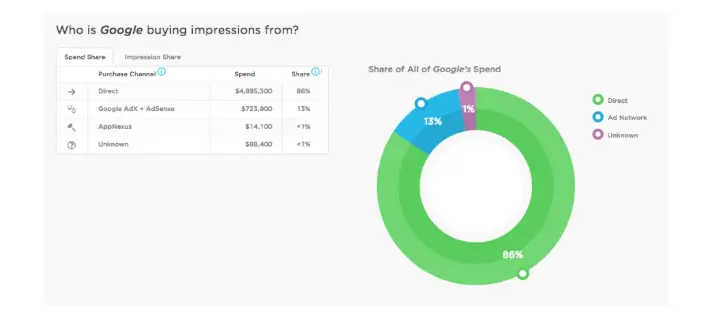It’s extraordinarily difficult for brands to gain actionable insight into how their digital ads perform across channels, where those ads are placed, and how their competitors are advertising.
One machine learning powered tool may have the answer.
Meet Pathmatics (@Pathmatics), a tool that solves both problems. The company’s digital advertising intelligence solutions use machine learning to show advertisers impressions and  spend across desktop, mobile and video. But, the company doesn’t just show you your brand’s ads—it also displays competitive intelligence on thousands of major advertisers. The result is AI-powered competitive intelligence into how and where brands advertise.
spend across desktop, mobile and video. But, the company doesn’t just show you your brand’s ads—it also displays competitive intelligence on thousands of major advertisers. The result is AI-powered competitive intelligence into how and where brands advertise.
We sat down with Ken Roberts (@KenWorking), head of marketing at Pathmatics, to learn how the company uses AI to make advertising more transparent.
In a single sentence or statement, describe Pathmatics.
Pathmatics’ digital advertising intelligence solutions are used by brands, agencies, ad tech companies, and publishers to build competitive advantages in their brand management, advertising, and business development activities.
How does Pathmatics use artificial intelligence (i.e. machine learning, natural language generation, natural language processing, deep learning, etc.)?
Machine learning is used in our models for impression and spend estimations. Pathmatics samples digital advertising and uses a number of factors about each ad occurrence along with external data sources to continually model market conditions, as well as accurately estimate impressions and spend.
What do you see as the limitations of artificial intelligence as it exists today?
In the digital ad ecosystem, the complexity of the marketplace—in terms of the number of technologies, the dynamic interconnections, and the pace of change—makes pulling together the right data quite challenging. We've uniquely solved an important piece of that puzzle already. But unlocking future potential in this industry means finding new creative ways to access the disparate data sources needed to build and apply rich datasets. It's part data availability and part complicated technology stacks.
What do you see as the future potential of artificial intelligence in marketing and sales?
Today, we use machine learning to turn data into insights for ad buyers and ad sellers. The future potential is to deploy these insights automatically, through AI, to convert insight into action. That will speed up the time from insight to change that benefits businesses.
What makes Pathmatics different than competing or traditional solutions?
We've been able to uniquely extract data regarding the ad path and decode all the intermediaries involved in each filled ad impression, which allows us to drive insights that no one else can. That's just the data capture side. We also apply that uniquely rich dataset in novel ways to forecast and predict for our users in ways previously unavailable.
Who are your prototype customers in terms of company size and industries?
We're broad in terms of our industries—anyone buying or selling digital advertising! This means brands, the agencies that serve the brands, the publishers that sell the advertising, and the ad tech firms that build the infrastructure.
Pathmatics provides offerings that scale from small businesses, such as performance marketers, to mid- and large-size brands and the agencies that serve them. We also have offerings for the publishers and ad tech companies serving both ends of the spectrum.
What are the primary use cases of Pathmatics for marketers and sales professionals?
If you are on the "buy side," you use Pathmatics for competitive intelligence that optimizes your brand strategy and advertising strategy, as well as to inform your ad execution, partner auditing, and reporting.
Our other big use case is on the “sell side” for publishers, agencies, and ad tech firms. Here they use Pathmatics ad intelligence to drive prospecting, prep, and pitching for new business. They also use Pathmatics for client service, customer upsell and retention.
Any other thoughts on AI in marketing, or advice for marketers who are just starting to explore the possibilities of AI?
With everything in marketing, always be testing! You should devote some amount of time and resources to testing AI tools and tactics to see what works for your market, marketing needs and goals.
As with Pathmatics, often AI is built into a platform that you are leveraging already. So here it is more about understanding how the "AI Inside" is making one platform stronger than another. You need to understand enough about AI and machine learning, both the hype and the potential, to parse through the claims and evaluate your product options.
Paul Roetzer
Paul Roetzer is founder and CEO of Marketing AI Institute. He is the author of Marketing Artificial Intelligence (Matt Holt Books, 2022) The Marketing Performance Blueprint (Wiley, 2014) and The Marketing Agency Blueprint (Wiley, 2012); and creator of the Marketing AI Conference (MAICON).



